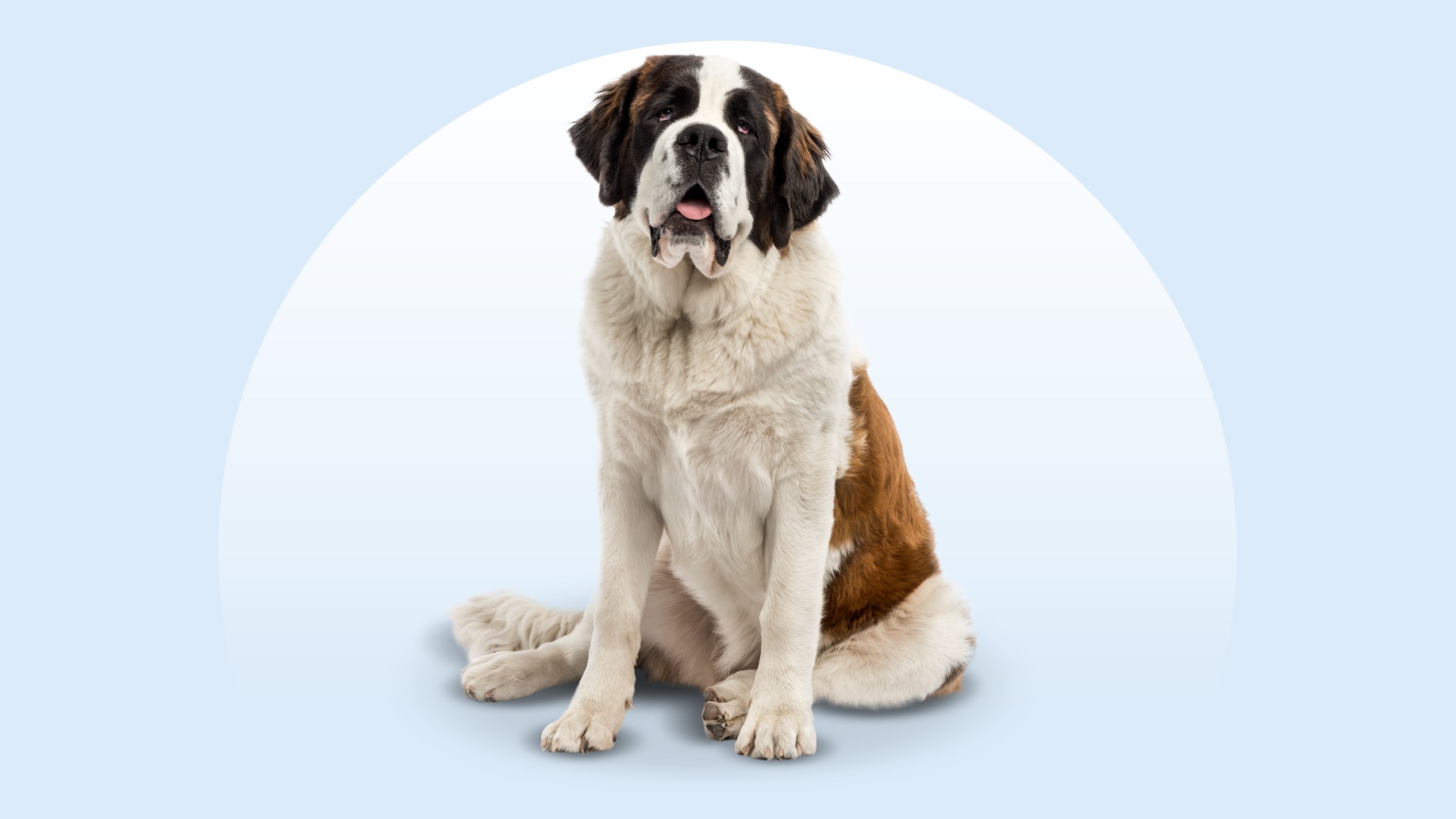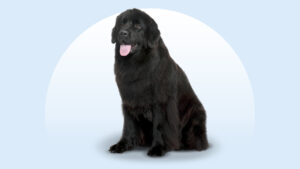Saint Bernard
Updated August 7, 2025
Saint Bernard
Updated August 7, 2025
Saint Bernards love everyone—their family, the neighbors, even the delivery person. These easygoing pups are extremely social, and they’ll thrive with a pet parent who can teach them the very best manners and take them on relaxing strolls to (literally) smell the roses.
Mellow, Outgoing, Sidekick
120–180 pounds
26–30 inches
8–10 years
Brown and White, Mahogany and White, Orange and White, Red and White, Brindle and White, Rust and White, White and Brown, White and Orange, White and Red
If you’ve ever thought to yourself, I’d love an affectionate, cheery lap dog, but make them the size of a baby horse, you’re in luck: The affable, tail-wagging Saint Bernard is pleased to make your acquaintance.
A calm and giant dog breed with soulful eyes, this ever-present sidekick attracts attention wherever they go. While Saint Bernards aren’t quite aware how big they are, cut them some slack when they accidentally take up the whole couch. They’ll make it up to you the next day by introducing you to new friends who interrupt your walk around the neighborhood to tell you how amazing your dog is.
Saint Bernard Characteristics
Saint Bernard Appearance
The Saint Bernard has a fluffy coat, floppy ears, intelligent eyes, and a gentle gaze in one big (like, well over 100-pound) package.

- Ears
A Saint Bernard has large, soft ears that flop over. You may find longer hair at the base of the ear.
- Eyes
They have dark, round eyes nestled beneath furrowed brows.
- Nose
The muzzle is square and long. They have a black nose with large nostrils.
- Coat Length
Saint Bernards have two types of coats: short and smooth or long and rough.
- Coat Color
Saint Bernard colors include red, brindle (subtle tiger stripes), brown, and orange. Their multicolor coats have white markings, too.
- Tail
Saints have long, heavy tails that often curl upward. You’ll see ample fluff on rough-coated dogs.
Saint Bernard Temperament
The Saint Bernard is a mellow, easygoing dog who just wants to make you happy. And whatever you’re doing, they’d like to join.
The moment you jangle your keys, they’re already in the car, delighted to be going wherever you had in mind. They’ll enjoy short adventures, like a quiet nature hike in cool weather, but save the more strenuous workouts for your time alone.
If you’re busy at home, chances are your Saint Bernard will be nearby, supervising from a cozy spot by your feet.
Their calm, gentle demeanor makes a Saint Bernard a great fit for families, and they usually get along well with kids, other dogs, and even cats. But they will need extra supervision around small kiddos to make sure they don’t accidentally knock anyone over.
A Saint Bernard’s size attracts a lot of attention—and thankfully, these friendly dogs welcome it. You’ll know your Saint Bernard is in their element when they’re happily drooling and wagging their tail.
How to Care for a Saint Bernard
Saint Bernards need only moderate exercise, but they will need regular grooming and plenty of training to be on their very best behavior. Of course, don’t forget the regular snuggles (these are mandatory).
Grooming
Training
Diet
Exercise
Environment
Saint Bernard Health
The typical Saint Bernard lifespan is 8–10 years; unfortunately, large dogs have shorter life expectancies than smaller breeds. Here are some health issues to be aware of.
- Bloat and gastric dilatation-volvulus (GDV): Saint Bernards, like other giant, deep-chested breeds, are prone to a life-threatening condition called bloat, when the stomach becomes distended with air and/or food. A serious complication of bloat is when the stomach twists on itself, cutting off blood supply to the organs (called GDV). Symptoms include abdominal distension, restlessness, and dry heaving. If you notice these signs, go to the vet immediately.
- Bone cancer: More formally known as osteosarcoma, bone cancer is common in Saint Bernards. Treatment often includes surgery, chemotherapy, and radiation.
- Dilated cardiomyopathy: Dilated cardiomyopathy is a genetic condition where the heart enlarges, possibly resulting in heart failure. Diagnosis is based on an echocardiogram and treatment is often daily medication.
- Elbow and hip dysplasia: Elbow and hip dysplasia are genetic conditions that develop during puppyhood when the joints don’t align well and become looser than normal. Signs include limping, and treatment might involve weight loss, reduced activity, joint supplements, physical therapy, or (in severe cases) surgery.
- Entropion: Entropion is an eyelid abnormality in which a dog’s eyelid rolls in on itself, potentially causing pain, eye infections, and ulcers on the cornea. Surgery is an option for severe cases.
- Heatstroke: Heatstroke is the result of a dog’s inability to cool their body down. Treat it as an emergency, as severe cases can be life-threatening. Symptoms include an elevated heart rate, panting, disorientation, seizures, vomiting, and diarrhea.
- Wobbler syndrome: Wobbler syndrome is a neurologic condition in dogs with large heads and necks like Saint Bernards. Also known as cervical spondylomyelopathy, it’s a painful disease of the neck vertebrae that affects the spinal cord and can lead to wobbly walking. It may be linked to nutrition, so ask your vet about a high-quality, large-breed puppy food and when to transition to adult food.
Saint Bernard History
It’s an often-repeated myth that Saint Bernards used to carry small wooden barrels filled with liquor attached to their collars for people to drink once they were rescued from avalanches. That never actually happened, and though this image is alive and well today in movies and cartoons, don’t expect your Saint Bernard to play bartender at your next party.
What we know for sure is that the Saint Bernard is named after monk Bernard of Menthon, a kind-hearted soul who lived around 1020. He established the Great Saint Bernard Hospice for people traversing the snowy Swiss Alps on their way to Rome, according to the Saint Bernard Club of America. In later years, the monks enlisted Saint Bernards to help lost travelers in treacherous mountain avalanches and snowdrifts.
The American Kennel Club recognized the breed in 1885. Saint Bernard puppies tend to cost around $1,500. If you choose this route, pick a responsible breeder.
You can also consider Saint Bernard adoption. You can find a Saint Bernard rescue dog via a local rescue like Sunny Saints Saint Bernard Rescue, keep an eye out for the breed at your local shelter, or search Chewy’s database of adoptable dogs in your area.








